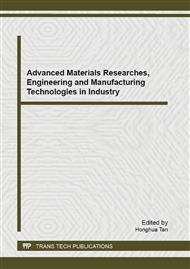p.30
p.35
p.40
p.46
p.52
p.58
p.65
p.71
p.75
Study on the Preparation and Particle Size Control of Silica Sphere in a Sol-Gel Process
Abstract:
Silica sphere has wide applications not only in the field of physical chemistry dealing with dynamic behavior and stability of particulate systems, but also in industries including catalysts, ceramics, pigments, pharmacy, etc. However, the control on the particle size is a key factor in the preparation process of silica sphere. In this paper, silica sphere with uniform sphere morphology and amorphous structure was prepared by a sol-gel method, and the control of particle size was emphatically studied. The results showed that the particle size of the as-prepared silica sphere was obviously influenced by the raw materials concentration. The average size of the product increased from 0.66 μm to 0.90 μm when ethanol concentration increased from 7.14M to 9.55M, increased from 0.50 μm to 0.90 μm with the increase of ammonia concentration in the range of 1.88M to 2.36M, and increased from 0.47 to 0.90 μm while tetraethoxysilane concentration increased from 0.08M to 0.11M. Further study indicated that the silica particle size was also influenced by reaction temperature, it increased with the increase of temperature from 26°C to 28°C, and decreased with the further increase of temperature in the scope of 28°C to 32°C.
Info:
Periodical:
Pages:
52-57
Citation:
Online since:
September 2013
Authors:
Keywords:
Price:
Сopyright:
© 2013 Trans Tech Publications Ltd. All Rights Reserved
Share:
Citation:


